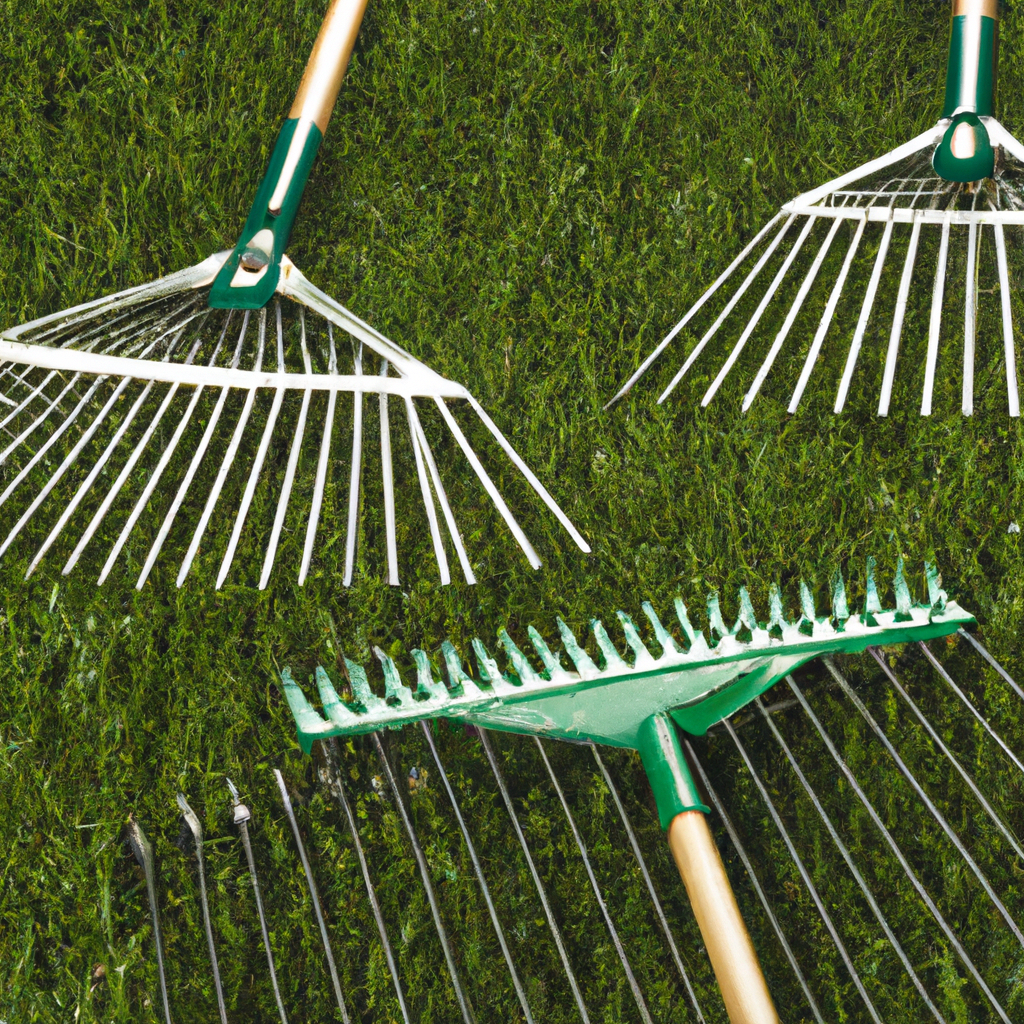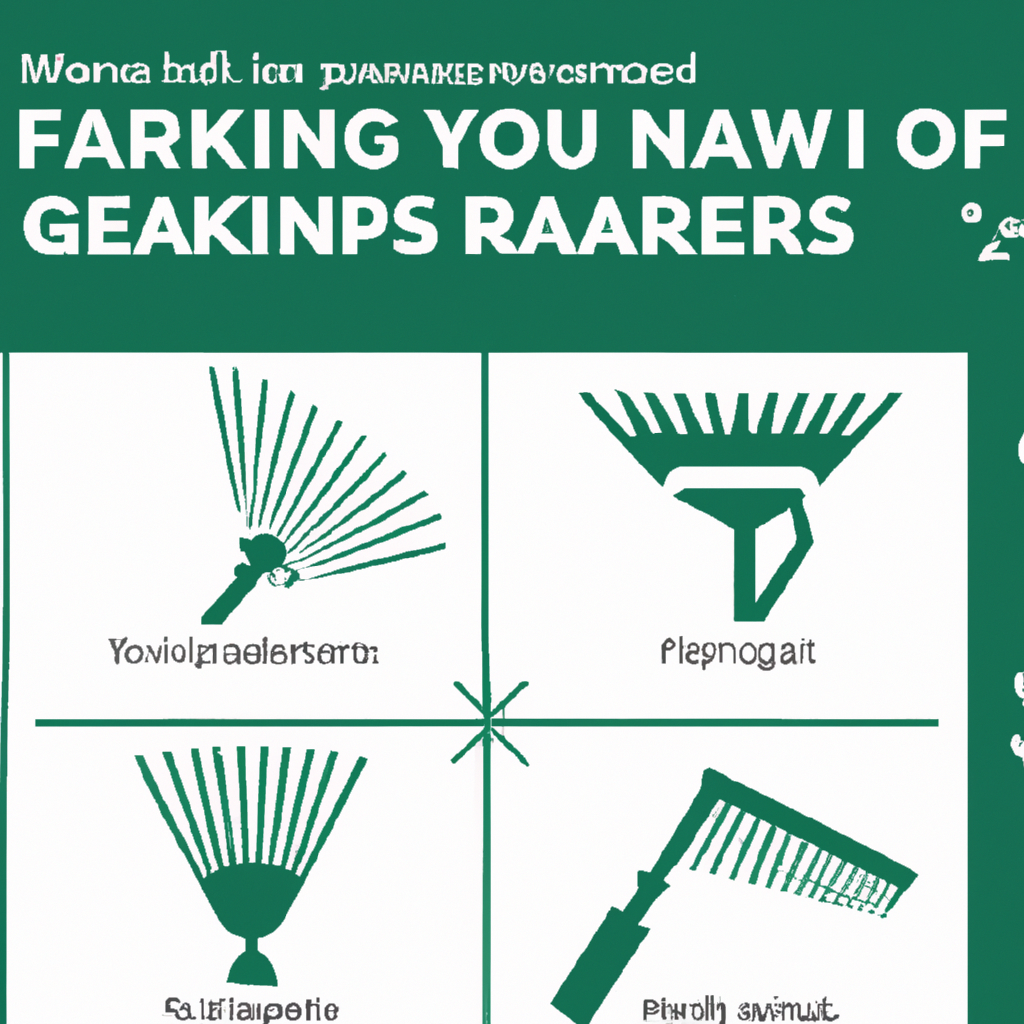So, you’re curious about turf rakes and want to understand the different types and features they offer? Look no further! In this article, we will break down the world of turf rakes, helping you gain a clearer understanding of their various options and functionalities. Whether you’re a seasoned landscaper or just starting out, this comprehensive guide will equip you with the knowledge you need to make an informed choice when it comes to selecting the perfect turf rake for your needs. From manual to power-driven, from adjustable heights to multiple attachments – we’ve got you covered. Let’s dive right in and explore the wonderful world of turf rakes!

Types of Turf Rakes
Turf rakes are essential tools for maintaining your lawn and keeping it healthy. There are various types of turf rakes available on the market, each with its own set of features and functionalities. In this article, we will explore three main types of turf rakes: manual turf rakes, motorized turf rakes, and tow-behind turf rakes. By understanding the differences between these types, you can choose the one that best suits your needs.
Manual Turf Rakes
Design and Functionality
Manual turf rakes are the most traditional and basic type of turf rakes. As the name suggests, these rakes require manual effort to operate. They typically consist of a long handle with a row of tines attached at the end. Some manual turf rakes may have a straight handle, while others might have an adjustable handle for added convenience.
These rakes are designed to remove thatch, moss, and other debris from your lawn. They work by combing through the grass, pulling out any unwanted materials. The tines on manual turf rakes are usually sharp and durable, allowing for effective removal without damaging the grass. Additionally, manual turf rakes are lightweight and easy to maneuver, making them suitable for small to medium-sized lawns.
Pros and Cons
One of the major advantages of manual turf rakes is their affordability. They are often the most budget-friendly option, making them accessible to homeowners with limited resources. Manual turf rakes also do not require any fuel or batteries, saving you money on ongoing operating costs.
However, the main disadvantage of manual turf rakes is the physical effort required to use them. If you have a large lawn or are not physically able to exert much force, manual turf rakes may not be the best choice for you. Additionally, these rakes can be time-consuming, especially when tackling larger areas.
Best Applications
Manual turf rakes are well-suited for small to medium-sized lawns where you can easily handle the physical effort required. They are ideal for homeowners who prefer a hands-on approach to lawn care and have the time to dedicate to thorough raking. If you have a tight budget or enjoy the satisfaction of manual labor, a manual turf rake may be the right choice for you.
Motorized Turf Rakes
Power Source Options
Motorized turf rakes, also known as power rakes or dethatchers, can be categorized based on their power sources. They are available in electric, cordless, and gas-powered options. The choice of power source depends on your specific needs and preferences.
Electric motorized turf rakes are powered by electricity, typically through a cord connected to a power outlet. They offer consistent power without the need for refueling or charging batteries. However, the presence of the cord limits their mobility and requires access to a power source.
Cordless motorized turf rakes, on the other hand, are powered by rechargeable batteries. They provide more mobility compared to electric models since there is no cord restricting movement. However, cordless rakes may have limited battery life, so it is essential to consider the runtime and charging time when choosing this option.
Gas-powered motorized turf rakes utilize gasoline or a gas/oil mixture to operate. These rakes offer the most power and are well-suited for large areas or heavy-duty tasks. They provide maximum mobility since they do not rely on cords or batteries. However, gas-powered models require regular refueling and maintenance.
Design and Functionality
Motorized turf rakes feature rotating blades or tines that dig into the grass and pull up debris, thatch, and moss. These rakes are generally more powerful and efficient compared to their manual counterparts. They cover a larger area in less time, making them a time-saving option for homeowners with larger lawns.
Most motorized turf rakes have adjustable settings to control the depth of the rake. This allows you to customize the raking process according to the condition of your turf. Some models may also have a collection system to gather the debris as you rake, minimizing the need for manual cleanup afterward.
Pros and Cons
The primary advantage of motorized turf rakes is their efficiency and time-saving nature. They can cover large areas quickly, making them ideal for homeowners with extensive lawns. Motorized rakes also require less physical effort compared to manual rakes, reducing strain on your body.
However, motorized turf rakes tend to be more expensive than manual rakes. Additionally, some models may be noisy, especially gas-powered ones. It is also important to consider the ongoing costs associated with gas or battery usage.
Best Applications
Motorized turf rakes are best suited for homeowners with medium to large-sized lawns and those who prioritize time efficiency. They are ideal for maintaining healthy and lush lawns without the need for excessive physical effort. If you have a larger budget and prefer the convenience of powered tools, a motorized turf rake may be the perfect choice for you.
Tow-Behind Turf Rakes
Usage with a Vehicle
Tow-behind turf rakes, as the name implies, are designed to be towed by a vehicle such as a lawn tractor or ATV. These rakes are typically larger and more heavy-duty compared to manual and motorized rakes. They are commonly used for commercial applications or for homeowners with extensive land.
Design and Functionality
Tow-behind turf rakes consist of a large rake assembly attached to a hitch, allowing them to be pulled behind a vehicle. The rake assembly usually includes multiple rows of tines or blades to cover a wide area. Some models may also have a collection system to gather the debris as you rake, making cleanup easier.
These rakes are designed to handle heavy-duty tasks such as dethatching, removing debris, and leveling uneven surfaces. They are more powerful and robust compared to manual and motorized rakes, making them suitable for larger properties.
Pros and Cons
The main advantage of tow-behind turf rakes is their ability to cover vast areas efficiently. They are a time-saving option for commercial landscapers or homeowners with large properties. Additionally, tow-behind rakes can handle heavy-duty tasks that may be challenging for manual or motorized rakes.
However, tow-behind turf rakes require a vehicle to operate, which may not be suitable for everyone. They are also larger in size and may require storage space when not in use. Additionally, the cost of tow-behind rakes is generally higher compared to other types.
Best Applications
Tow-behind turf rakes are best suited for homeowners with extensive land, commercial landscapers, or those who require heavy-duty turf maintenance. If you have a large property or need to tackle challenging tasks, a tow-behind turf rake can be a valuable tool.

Features to Consider
When choosing a turf rake, it is important to consider various features that can affect its performance and suitability for your specific needs. Here are some key features to keep in mind:
Rake Width
The rake width refers to the width of the rake head or assembly. A wider rake width allows you to cover a larger area in less time. However, you should balance the rake width with maneuverability, especially if you have narrow or tight spaces to navigate.
Raking Depth
The raking depth determines how deeply the rake tines or blades penetrate the turf. Different turf conditions may require different rake depths. It is important to choose a turf rake that offers adjustable depth settings to accommodate various turf conditions.
Adjustability
The ability to adjust the rake height is essential for different turf surfaces. Some areas may require a more gentle touch, while others may need deeper raking. Look for turf rakes that offer adjustable height settings to cater to the specific needs of your lawn.
Rake Tines
Consider the material and durability of the rake tines. Stainless steel or hardened steel tines are often more durable and resistant to bending or breaking. The spacing and quantity of tines also play a role in the rake’s effectiveness. Different turf types may require specific tine designs.
Collection System
Some motorized and tow-behind turf rakes may have a collection system to gather the debris as you rake. This can save you time and effort in manual cleanup. Consider whether a collection system is important to you and choose a rake with this feature if needed.
Weight and Maneuverability
Consider the weight of the turf rake and whether it is manageable for you. Heavier rakes may provide better penetration, but they can also be difficult to maneuver, especially for extended periods. Balancing weight and maneuverability is crucial for a comfortable raking experience.
Durability
Look for a turf rake that is built to last. Consider the overall construction and materials used to ensure durability. Read customer reviews and check for warranties to get an idea of the product’s longevity and reliability.
Attachments and Accessories
Some turf rakes may offer additional attachments or accessories that enhance their functionality. These can include detaching blades, moss rakes, or brushes. Consider whether you need any additional attachments for your specific turf maintenance needs.
Maintenance
Consider the maintenance requirements of the turf rake. Some models may require more frequent cleaning or blade replacement. Read the manufacturer’s instructions and customer reviews to understand the maintenance needs and costs associated with the turf rake.
Price Range
Price is an important factor to consider when purchasing a turf rake. Set a budget and consider the value you will get for your money. Compare prices across different brands and models, taking into account the features and durability offered.
Rake Width
Importance for Efficiency
The rake width plays a significant role in the efficiency of your turf raking. A wider rake head or assembly allows you to cover a larger area with each pass, reducing the overall time and effort required. If you have a small lawn, a narrower rake width may be sufficient. However, for larger properties, a wider rake width can save you valuable time and energy.
Considerations for Different Application Areas
Different areas of your lawn may require different rake widths. For open areas without any obstacles, a wider rake width can be more efficient. On the other hand, if you have narrow spaces or tight corners, a narrower rake width will provide better maneuverability. Consider the layout of your lawn and any potential obstacles when choosing the appropriate rake width.
Ideal Widths for Various Turf Sizes
The ideal rake width depends on the size of your lawn. For small to medium-sized lawns, a rake width between 18 and 24 inches is typically sufficient. Larger lawns may benefit from wider rake widths, ranging from 24 to 36 inches. Remember to consider your ability to maneuver the rake comfortably and effectively while choosing the ideal width for your turf size.

Raking Depth
Determining the Depth
The raking depth refers to how deeply the rake tines or blades penetrate the turf. Determining the appropriate raking depth depends on the condition of your turf and your desired outcome. Thoroughly assessing your lawn will give you an idea of how deeply you need to rake.
Adjustability for Different Turf Conditions
Different turf conditions may require different raking depths. For dense and heavily thatched lawns, a deeper raking depth may be necessary. In contrast, for areas with delicate grass or shallow-rooted plants, a more shallow raking depth is recommended. Look for a turf rake that offers adjustable depth settings to cater to various turf conditions.
Common Depth Settings
Common depth settings for turf rakes range from 1/4 inch to 1 inch. Light dethatching or surface-level cleanup can be achieved with a shallow raking depth of around 1/4 inch. For moderate dethatching and removal of embedded thatch, a depth of 1/2 to 3/4 inch may be sufficient. Deeper raking depths, around 1 inch, are typically reserved for heavy-duty dethatching or renovation of highly thatched lawns.
Adjustability
Ability to Modify Rake Height
Adjustability is an important feature to consider, as it allows you to modify the rake height according to the specific needs of your lawn. Different turf surfaces may require different rake settings for optimal results. Look for a turf rake that offers user-friendly adjustment mechanisms for hassle-free customization.
Importance for Different Turf Surfaces
Different turf surfaces have varying sensitivity levels and maintenance requirements. For delicate grasses, such as bentgrass or fine fescue, a gentler rake height is recommended to avoid damaging the turf. On the other hand, more robust grass types, like Kentucky bluegrass or perennial ryegrass, can tolerate deeper rake settings. The ability to adjust the rake height ensures that you can cater to the specific requirements of your turf surface.
Adjustment Mechanisms
Turf rakes may offer different adjustment mechanisms to modify the rake height. These mechanisms can include lever systems, adjustable wheels, or telescopic handles. Consider the ease of use and convenience of the adjustment mechanism when choosing a turf rake.

Rake Tines
Material and Durability
The material of the rake tines plays a crucial role in their durability and effectiveness. Stainless steel or hardened steel tines are often more resistant to bending or breaking, ensuring a longer lifespan. Avoid rakes with tines made of low-quality materials that may not withstand frequent use or more demanding tasks.
Spacing and Quantity
The spacing and quantity of the rake tines determine their effectiveness in removing thatch and debris. Closer-spaced tines are better equipped to handle finer or smaller debris, while wider-spaced tines can tackle larger or clumpy materials. The quantity of tines should also be considered, as more tines generally mean greater coverage and efficiency.
Designs for Different Turf Types
Different turf types may require specific tine designs for optimal performance. For example, if you have a fine-textured turf, such as Bermuda grass, you may need tines designed to penetrate the dense thatch. On the other hand, if you have a coarser turf, like Zoysia grass, tines with a thicker gauge may be more suitable. Consider the specific needs of your turf type and choose a rake with tines that align with those requirements.
Price Range
Value for Money
When considering the price range of turf rakes, it is important to evaluate the value for money they offer. Look beyond the initial cost and consider the features, durability, and performance of the rake. A more expensive model may provide better durability and functionality, resulting in long-term savings. Conversely, a cheaper option may save you money upfront, but it may not offer the same level of performance and may require frequent replacement.
Factors Affecting Price
Several factors can impact the price of turf rakes. These include the type of rake (manual, motorized, or tow-behind), the brand, the material quality, additional features, and the overall construction. Consider your specific needs and budget when determining the price range that works for you.
Comparing Different Brands and Models
When comparing different brands and models, look for reputable manufacturers known for producing quality turf rakes. Read customer reviews and seek recommendations from professionals or experienced users. By comparing different options, you can make an informed decision and select a turf rake that offers the best balance of price and performance.
In conclusion, understanding the different types and features of turf rakes is essential for choosing the right tool for your lawn maintenance needs. Whether you opt for a manual turf rake, motorized turf rake, or tow-behind turf rake, consider the specific design, functionality, and best applications of each type. Additionally, factors such as rake width, raking depth, adjustability, rake tines, collection system, weight and maneuverability, durability, attachments and accessories, maintenance, and price range should be taken into account. By considering these factors, you can ensure that your chosen turf rake meets your requirements and helps you achieve a healthy and vibrant lawn. Happy raking!

